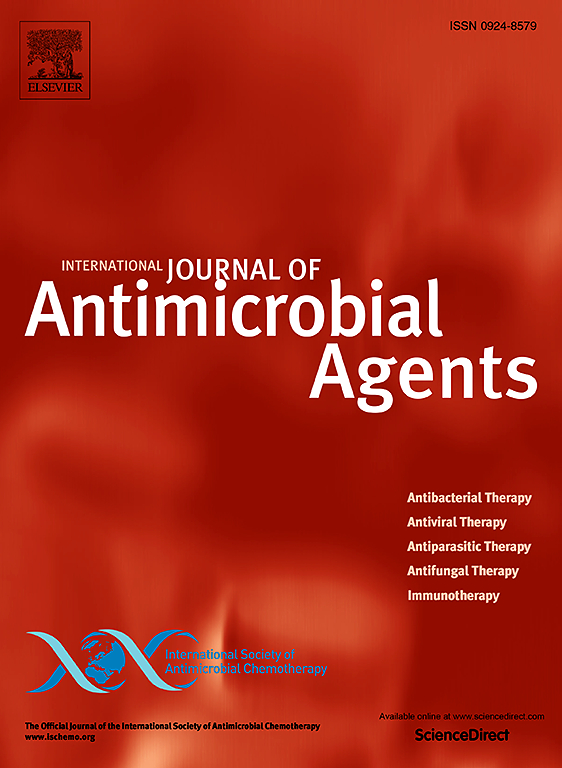大肠杆菌对环丙沙星和恩诺沙星的适应:SOS反应的差异蛋白质组学和不依赖reca的机制
IF 4.9
2区 医学
Q1 INFECTIOUS DISEASES
International Journal of Antimicrobial Agents
Pub Date : 2025-02-01
DOI:10.1016/j.ijantimicag.2024.107420
引用次数: 0
摘要
抗生素耐药性是一个日益严重的全球卫生保健挑战,用氟喹诺酮类药物治疗细菌感染也不例外。这些抗生素可以通过几种机制诱导遗传不稳定,其中最重要的是SOS反应的激活。在暴露于亚致死浓度时,这种应激反应增加了突变率,加速了抗性的进化。为了探索SOS应答在氟喹诺酮类药物适应中的作用,我们通过暴露于逐步增加浓度的野生型大肠杆菌(MG1655)和缺乏SOS激活的ΔrecA突变菌株,诱导其重新产生耐药性。这两种菌株都暴露于环丙沙星和恩诺沙星浓度逐步增加的环境中,这两种氟喹诺酮类药物只相差一个甲基。对这两种氟喹诺酮类药物的耐药性在ΔrecA突变体中严重受阻。虽然这些抗生素通常被认为会引起类似的细胞反应,但我们的数据显示了不同的基因组和适应性差异。基于这些发现,我们进行了比较蛋白质组学分析,以研究大肠杆菌如何在蛋白质水平上适应环丙沙星和恩诺沙星。结果表明,环丙沙星和恩诺沙星之间的轻微结构差异导致了独特的蛋白质组适应。这些发现表明,即使是细微的化学差异也可以导致不同的适应轨迹,并说明细胞应激反应的灵活性。本文章由计算机程序翻译,如有差异,请以英文原文为准。

Adaptation of Escherichia coli to ciprofloxacin and enrofloxacin: Differential proteomics of the SOS response and RecA-independent mechanisms
Objective
Antibiotic resistance is a growing global healthcare challenge, treatment of bacterial infections with fluoroquinolones being no exception. These antibiotics can induce genetic instability through several mechanisms, one of the most significant being the activation of the SOS response. During exposure to sublethal concentration, this stress response increases mutation rates, accelerating resistance evolution.
Methods
To explore the role of the SOS response in fluoroquinolone adaptation, we induced de novo resistance by exposure to step-wise increasing concentrations Escherichia coli wild-type (MG1655) and a ΔrecA mutant strain, which is deficient in SOS activation. Both strains were exposed to stepwise increasing concentrations of ciprofloxacin and enrofloxacin – two fluoroquinolones that differ only by a single methyl group.
Results
Development of resistance against both fluoroquinolones was severely hampered in the ΔrecA mutant. While these antibiotics are often assumed to elicit similar cellular responses, our data revealed distinct genomic and adaptive differences. Building on these findings, we performed a comparative proteomics analysis to investigate how E. coli adapts to ciprofloxacin and enrofloxacin at the protein level.
Conclusions
The results demonstrate that the slight structural variation between ciprofloxacin and enrofloxacin leads to unique proteomic adaptations. These findings suggest that even subtle chemical differences can lead to distinct adaptive trajectories and illustrate the flexibility of cellular stress responses.
求助全文
通过发布文献求助,成功后即可免费获取论文全文。
去求助
来源期刊
CiteScore
21.60
自引率
0.90%
发文量
176
审稿时长
36 days
期刊介绍:
The International Journal of Antimicrobial Agents is a peer-reviewed publication offering comprehensive and current reference information on the physical, pharmacological, in vitro, and clinical properties of individual antimicrobial agents, covering antiviral, antiparasitic, antibacterial, and antifungal agents. The journal not only communicates new trends and developments through authoritative review articles but also addresses the critical issue of antimicrobial resistance, both in hospital and community settings. Published content includes solicited reviews by leading experts and high-quality original research papers in the specified fields.

 求助内容:
求助内容: 应助结果提醒方式:
应助结果提醒方式:


